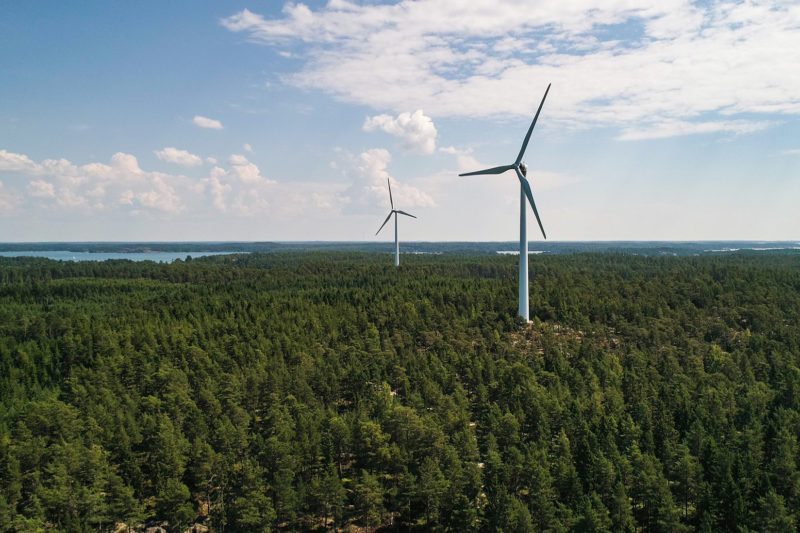Forest company plans to process carbon dioxide from mills into bio products

For Metsä Group, the recovery of carbon dioxide represents a business potential of several thousand million euros.
Metsä Group, one of the major forest companies in Finland, has plans to enter the renewable methanol market by using the carbon dioxide released in its mills.
’We have joined forces with Fortum to explore the potential of recovering wood-based carbon dioxide and utilizing it for bio products to replace fossil materials,’ says Pirita Mikkanen, Metsä Group’s Vice President (Energy).
The plans are based on the global improvement seen in hydrogen technology and the fact that wood-based carbon dioxide remains mostly unutilized as raw material.
’The recovery technology of wood-based carbon dioxide has improved. There are now better conditions for processing it into bio products,’ Mikkanen says.
Besides Metsä Group, other Nordic companies investing in hydrogen economy include at least the forest company UPM, as well as STI, SSAB, Boliden and the City of Helsinki energy company Helen.
Hydrogen economy as part of green transfer
As part of the green transfer, hydrogen economy is the object of great expectations in the EU. The Union’s hydrogen road map, published in 2020, estimated that the investments into hydrogen economy will exceed EUR 30 thousand million in a decade.

’This is a big enough input that the technologies, which are as yet commercially immature or not efficient enough, can be developed to reach profitability,’ says Mikkanen.
Mikkanen also points out that despite the abundance of public funding available for hydrogen economy, the business must still be profitable under market conditions.
Metsä Group’s plans focus on what is called the Power-to-X (P2X) process. With this, wind electricity or other renewable energy is converted to hydrogen and oxygen by electrolysis. The hydrogen can be combined with carbon dioxide and processed into organic compounds, one of which is methanol.
Mikkanen says that even now, small-scale processing of wood-based carbon is possible.
’There are several development projects under way in Finland and elsewhere, for scaling different P2X processes. So far, they cannot compete with corresponding fossil products.’
Methanol requires no new distribution network
In contrast to hydrogen, the use of methanol from carbon dioxide does not require new technology or the construction of new distribution systems.
In the future, methanol from wood-based carbon dioxide can be used as fuel in cars, at least to some extent. The projects are mainly concerned with the production of fuels, as the so-called distribution obligation requires that petrol and diesel, for example, must be mixed with renewable fuel. In maritime transport, methanol can be used on its own.
’Besides as fuel, methanol is one of the most important basic raw materials of the chemical industry. It can be processed further into a range of products, such as adhesives, solvents and plastics,’ Mikkanen says.
The burning of methanol does release carbon dioxide into the atmosphere, but the emissions are smaller since it replaces fossil fuels with synthetic, in other words, chemically manufactured fuel.
As an example, the two million tons of aviation fuel used by Finnair at the Helsinki-Vantaa airport could almost be produced using the carbon dioxide from a single pulp mill.
The recovery of carbon dioxide is not just something you do for want of a better idea. In an interview with the Tekniikan Maailma magazine, Research Director Petteri Laaksonen of the Lappeenranta–Lahti University of Technology says that the total carbon dioxide emissions from Finland’s pulp mills are about 24 million metric tons.
’That would allow you to produce all the fuel consumed in Finland, and there’d still be the same amount available for export. As an example, the two million tons of aviation fuel used by Finnair at the Helsinki-Vantaa airport could almost be produced using the carbon dioxide from a single pulp mill,’ Laaksonen says to Tekniikan Maailma.
Carbon dioxide refined into methanol
The company P2X Solutions is set to start a green methanol production facility in Harjavalta, western Finland, next year. Some of the hydrogen produced there will be processed directly into synthetic methane.
For the forest industry, hydrogen economy opens up the opportunity to utilize the carbon dioxide generated in the operation. The expected magnitude of the hydrogen business value is thousands of millions.
How is this sum calculated? According to Mikkanen, Metsä Group’s production facilities produce annually a sidestream of about 10 million metric tons of wood-based carbon dioxide.

This quantity could be turned into over seven million tons of methanol. And since the price per ton of methanol on the world market is at least USD 400 (EUR 365), getting the business going is sure to bring in thousands of millions. Renewable methanol actually commands even higher prices.
Availability of energy is key
The main constraint in developing the hydrogen economy is the availability of energy. Pirita Mikkanen says that the production of seven million tons of methanol would swallow a considerable chunk of Finland’s current energy production, and this constrains the utilization of carbon dioxide.
The energy production capacity is increasing with the planned construction of wind power. There is potential for a considerably higher production.
The key here are new energy solutions. Existing plans for new wind power capacity exceed Finland’s current demand projections – many times over, in fact.
’The energy production capacity is increasing with the planned construction of wind power. There is potential for a considerably higher production,’ Mikkanen says.
For Finland, hydrogen economy represents a great opportunity. The country has plans to become the European leader in hydrogen economy, across the entire value chain. Finland has the capacity to produce at least ten percent of zero-emission hydrogen in the EU by 2030, as was estimated in February in a resolution by Sanna Marin’s government.